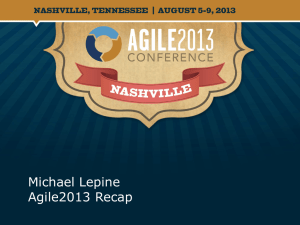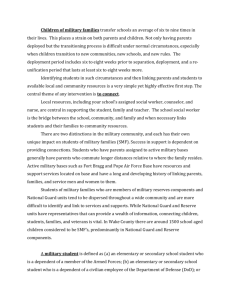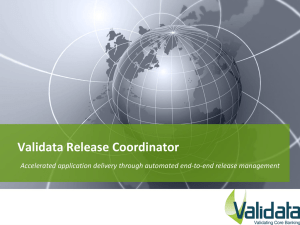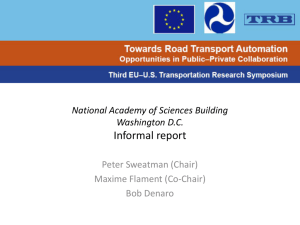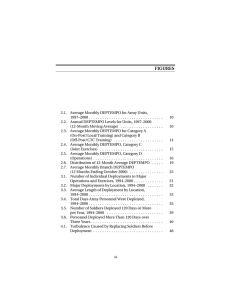Death to Manual Deployments
advertisement
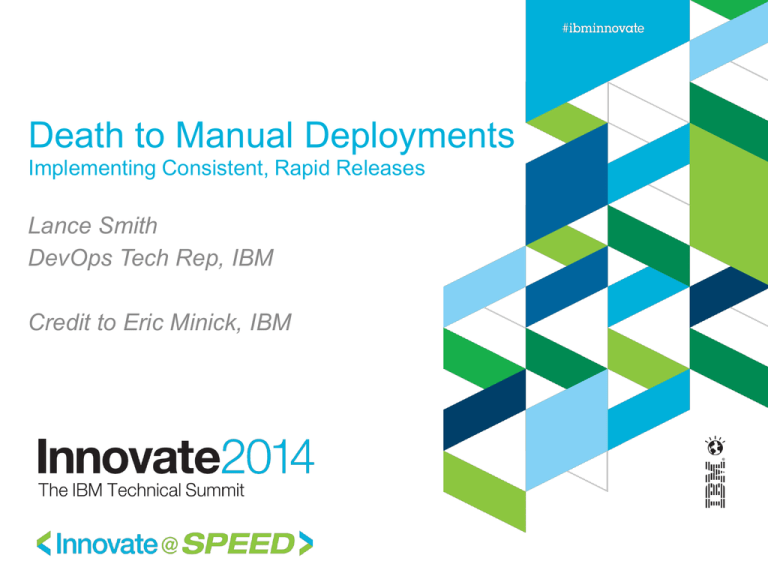
Death to Manual Deployments Implementing Consistent, Rapid Releases Lance Smith DevOps Tech Rep, IBM Credit to Eric Minick, IBM Please note IBM’s statements regarding its plans, directions, and intent are subject to change or withdrawal without notice at IBM’s sole discretion. Information regarding potential future products is intended to outline our general product direction and it should not be relied on in making a purchasing decision. The information mentioned regarding potential future products is not a commitment, promise, or legal obligation to deliver any material, code or functionality. Information about potential future products may not be incorporated into any contract. The development, release, and timing of any future features or functionality described for our products remains at our sole discretion. Performance is based on measurements and projections using standard IBM benchmarks in a controlled environment. The actual throughput or performance that any user will experience will vary depending upon many factors, including considerations such as the amount of multiprogramming in the user’s job stream, the I/O configuration, the storage configuration, and the workload processed. Therefore, no assurance can be given that an individual user will achieve results similar to those stated here. Confession: I hate manual deployments • • • • They’re slow They aren’t consistent across environments You fail in production You don’t know who deployed what, where or when Why do people like manual deployments? • I feel more in control from the command line • It’s how I’ve always done it • I know what I did and see the output of the commands I ran • When something goes wrong, I can be the hero and fix it ? Scripts to the rescue?!? • I don’t have a manual deployment: I have scripts! – – – – – How many scripts? What order? Who has permissions to run them? Are they the same across environments? What else do you need to do? • Scripts are only part of a fully automated deployment. I love automated deployments • • • • They’re NOT slow They ARE consistent across environments You DON’T fail in production You DO know who deployed what, where or when Automated deployments provide benefits • Provide a platform you can build on – continuous deploys, smoke tests, other goodies • Empower people while increasing control – stop waiting on other people – stop being harassed by other people • Better, Faster, Cheaper (Pick any 3) The Program • Today’s Manual Deployments • Elements of an Automated Solution • Best Practices with Automated Deployments The Program • Today’s Manual Deployments • Elements of an Automated Solution • Best Practices with Automated Deployments … you might have a manual deployment • • • • • • Hand-offs are through email (or file shares) Developers, QA, and Ops deploy differently Tweaks communicated on an as-broken basis Deployments steps are a huge document The term “deployment weekend” is used Developers have production passwords Hand-offs are through email (or file shares) • • • • They’re slow They aren’t consistent across environments You fail in production You don’t know who deployed what, where or when ? Developers, QA, and Ops deploy differently • • • • They’re slow They aren’t consistent across environments You fail in production You don’t know who deployed what, where or when Tweaks communicated as-broken • • • • They’re slow They aren’t consistent across environments You fail in production You don’t know who deployed what, where or when The main page won’t load? Oh… Right, you needed to add another data source. Deployments steps are a huge document • • • • They’re slow They aren’t consistent across environments You fail in production You don’t know who deployed what, where or when The term “deployment weekend” is used • They’re slow • They aren’t consistent across environments • You fail in production • You don’t know who deployed what, where or when That’s ok, I don’t really like my kids anyway Developers have production passwords • • • • They’re slow They aren’t consistent across environments You fail in production You don’t know who deployed what, where or when ♫ If only people were more disciplined… • Deployment docs – could capture everything – always be updated – could be followed them, perfectly, every time. • Audit spreadsheets – could capture everything – could update them Image from: http://www.ultimatebasictraining.com/blog/2010/02/what-area-drill-sergeants-like/ People aren’t machines Creative Consistent Automated deployments leverage the strengths of people and machines. Alistair Cockburn, “Characterizing People as Non-Linear, First-Order Components in Software Development” Automated deploy dev to prod isn’t natural Conway’s Law: organizations are constrained to produce solutions that copy the structure of their organization Automated deploy dev to prod isn’t natural Conway’s Law: organizations are constrained to produce solutions that copy the structure of their organization • Ops wants to maintain control • Development wants fast feedback • QA lacks influence in DEV & PROD The Program • Today’s Manual Deployments • Elements of an Automated Solution • Best Practices with Automated Deployments Elements of an automated solution • • • • • • Automated process Coordinating tiers Environment definitions Artifact repository Access control Audit trail Automated process Fast, consistent and repeatable Status Quo • Don’t exist • Incomplete • Multiple order-dependent scripts • Multiple versions per environment (or machine) • Uncontrolled What we need • Single script reused across environments • Controlled access to deployment steps • Auto record what happened Coordinating Tiers / Components Move all tiers, services, config etc together Status Quo What we need • Based on oral history • In a spreadsheet • Plan is redesigned every time based on changes • A model for whole systems • Standard deployment based on changes to all pieces and parts • Actual deployment runs the needed subset. Snapshots Transitions of Components Dev QA Prod ? ? Transitions of a Snapshot Dev QA Snapshot Snapshot Prod Environment definitions Per-environment configuration and passwords Status Quo What we need • Configured manually • Details embedded in binaries, scripts, property files, ini files • Environment information either uncontrolled or in source control • Environments a first-level entity • Properties controlled at the environment level • Secure storage of sensitive values (passwords) Artifact repository Know what you’re getting Status Quo What we need • • • • • • Definitive Software Library • Consistent set of artifacts across environments • Tamper-proof artifacts • Automated retention policies based on deployments Is email a repository File share on the network Source control for binary control Uncontrolled Crude control over what to keep Access control Who can deploy to which environment Status Quo • Controlled by who can log onto the machine • Access tends to grow over time in response to crisis • Access control distributed across machines What we need • Role-based access control • Access control by environment • Single source of access control • LDAP / Active Directory authentication (or authorization) Audit trail Know what happened Status Quo What we need • What audit trail? • I have the spreadsheet • Our Change Management System has what we think we did • Audit trail starts at PROD • Win at Clue: – – – – Who What Where When / How (better than Clue!) • Require no additional work • End-to-end traceability Solution Benefits • We have confidence that our production deployments will succeed • QA can take new builds faster • DEV deployments fast enough to keep up with our rate of change • We have an audit trail from day one • We have separation of duties The Program • Today’s Manual Deployments • Elements of an Automated Solution • Best Practices with Automated Deployments Automated Deployments Best Practices • • • • • • Deferred deployments Self-service deployments Automatic deployment Automatic smoke-test Automated rollbacks Continuous production deployment Deferred deployments • Story: I want to do my deployment at 11 pm on Friday after my users are offline. • Solution: Schedule deployment for desired time, go home. Wait for notification of success or failure. Self-service deployments • Story: QA wants to be able to take a new build when they need one. • Solution: Use per-environment access control to allow the QA people to deploy on-demand, but only to the test environment. Automatic deployment • Story: Want to keep the development test server in sync with the latest changes in source control. • Solution: After building, automatically deploy to the development server. Automatic smoke-test • Story: I want to know if something breaks immediately. • Solution: After deploying, automatically trigger a suite of automated tests and report the results. Automated rollback • Story: If my deployment fails I want to restore the previous build. • Solution: When a deployment step fails, trigger the restoration of the last successfully deployed build. Continuous production deployments • Story: When a change is committed it should be deployed to production if it doesn’t break anything. • Solution: After deployment to test environment run automated test suites. If they all pass, trigger a deployment to production, then test that production deploy was successful. Rollback on failure. Summary • Manual deployments are slow and broken because they require people to act like machines • Computers make good machines • Automated deployments provide a solid foundation for further improvement Deployment and Release Products • UrbanCode Deploy – Application Release Automation • UrbanCode Release – Release management planning and release weekend execution Great Resources for more learning! IBM’s DevOps Developerworks Community IBM Public DevOps Page: DevOps For Dummies Book: Release and Deploy For Dummies Book: 41 41 Slideshare.net/Urbancode Ibmdw.net/urbancode/documents Ibmdw.net/urbancode/blog/ lansmith@us.ibm.com 42 Thank You!
